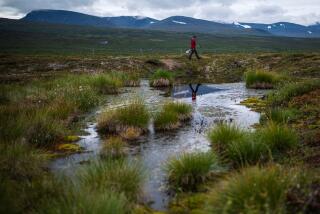Record Arctic ice shrinkage is seen as global warming effect
- Share via
There was less sea ice in the Arctic on Friday than ever before on record, and the melting is continuing, the National Snow and Ice Data Center reported.
“Today is a historic day,” said Mark Serreze, a senior research scientist at the center in Boulder, Colo. “This is the least sea ice we’ve ever seen in the satellite record, and we have another month left to go in the melt season this year.”
Scientists began monitoring the extent of Arctic sea ice in the 1970s, when satellite images became available.
“It is very strong evidence that we are starting to see an effect of greenhouse warming,” Serreze said.
Satellite measurements showed 2.02 million square miles of ice in the Arctic; the previous record low, from Sept. 21, 2005, was 2.05 million square miles, the agency said.
Sea ice is particularly diminished in the East Siberian side of the Arctic and the Beaufort Sea north of Alaska, the center reported.
Ice in the Canadian Archipelago is also quite depleted. Along the Atlantic side of the Arctic Ocean, there is less sea ice than normal, but the amount isn’t as drastically reduced, the center said.
The polar regions have long been of concern because scientists expect those regions to show the effect of climate change sooner and more than other areas do.
Unusually clear skies in June and July have meant more sunshine in the Arctic while the sun is at its highest.
The resulting solar energy on the Arctic ice surface has accelerated melting, the center said, and winds brought more warm air from the south.
The melting is occurring faster than computer climate models predicted, Serreze said.
Several years ago, he said, he would have expected a complete summer melt of Arctic sea ice by the end of the century -- maybe a few decades earlier. But at current rates, a complete summer melt could happen by 2030, he said.
More to Read
Sign up for Essential California
The most important California stories and recommendations in your inbox every morning.
You may occasionally receive promotional content from the Los Angeles Times.









